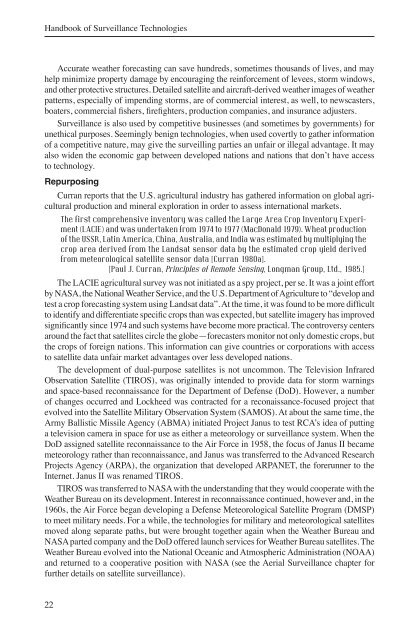Handbook of Surveillance Technologies (3rd Ed) - The Real Faces of ...
Handbook of Surveillance Technologies (3rd Ed) - The Real Faces of ...
Handbook of Surveillance Technologies (3rd Ed) - The Real Faces of ...
Create successful ePaper yourself
Turn your PDF publications into a flip-book with our unique Google optimized e-Paper software.
<strong>Handbook</strong> <strong>of</strong> <strong>Surveillance</strong> <strong>Technologies</strong><br />
Accurate weather forecasting can save hundreds, sometimes thousands <strong>of</strong> lives, and may<br />
help minimize property damage by encouraging the reinforcement <strong>of</strong> levees, storm windows,<br />
and other protective structures. Detailed satellite and aircraft-derived weather images <strong>of</strong> weather<br />
patterns, especially <strong>of</strong> impending storms, are <strong>of</strong> commercial interest, as well, to newscasters,<br />
boaters, commercial fishers, firefighters, production companies, and insurance adjusters.<br />
<strong>Surveillance</strong> is also used by competitive businesses (and sometimes by governments) for<br />
unethical purposes. Seemingly benign technologies, when used covertly to gather information<br />
<strong>of</strong> a competitive nature, may give the surveilling parties an unfair or illegal advantage. It may<br />
also widen the economic gap between developed nations and nations that don’t have access<br />
to technology.<br />
Repurposing<br />
Curran reports that the U.S. agricultural industry has gathered information on global agricultural<br />
production and mineral exploration in order to assess international markets.<br />
<strong>The</strong> first comprehensive inventory was called the Large Area Crop Inventory Experiment<br />
(LACIE) and was undertaken from 1974 to 1977 (MacDonald 1979). Wheat production<br />
<strong>of</strong> the USSR, Latin America, China, Australia, and India was estimated by multiplying the<br />
crop area derived from the Landsat sensor data by the estimated crop yield derived<br />
from meteorological satellite sensor data [Curran 1980a].<br />
[Paul J. Curran, Principles <strong>of</strong> Remote Sensing, Longman Group, Ltd., 1985.]<br />
<strong>The</strong> LACIE agricultural survey was not initiated as a spy project, per se. It was a joint effort<br />
by NASA, the National Weather Service, and the U.S. Department <strong>of</strong> Agriculture to “develop and<br />
test a crop forecasting system using Landsat data”. At the time, it was found to be more difficult<br />
to identify and differentiate specific crops than was expected, but satellite imagery has improved<br />
significantly since 1974 and such systems have become more practical. <strong>The</strong> controversy centers<br />
around the fact that satellites circle the globe—forecasters monitor not only domestic crops, but<br />
the crops <strong>of</strong> foreign nations. This information can give countries or corporations with access<br />
to satellite data unfair market advantages over less developed nations.<br />
<strong>The</strong> development <strong>of</strong> dual-purpose satellites is not uncommon. <strong>The</strong> Television Infrared<br />
Observation Satellite (TIROS), was originally intended to provide data for storm warnings<br />
and space-based reconnaissance for the Department <strong>of</strong> Defense (DoD). However, a number<br />
<strong>of</strong> changes occurred and Lockheed was contracted for a reconaissance-focused project that<br />
evolved into the Satellite Military Observation System (SAMOS). At about the same time, the<br />
Army Ballistic Missile Agency (ABMA) initiated Project Janus to test RCA’s idea <strong>of</strong> putting<br />
a television camera in space for use as either a meteorology or surveillance system. When the<br />
DoD assigned satellite reconnaissance to the Air Force in 1958, the focus <strong>of</strong> Janus II became<br />
meteorology rather than reconnaissance, and Janus was transferred to the Advanced Research<br />
Projects Agency (ARPA), the organization that developed ARPANET, the forerunner to the<br />
Internet. Janus II was renamed TIROS.<br />
TIROS was transferred to NASA with the understanding that they would cooperate with the<br />
Weather Bureau on its development. Interest in reconnaissance continued, however and, in the<br />
1960s, the Air Force began developing a Defense Meteorological Satellite Program (DMSP)<br />
to meet military needs. For a while, the technologies for military and meteorological satellites<br />
moved along separate paths, but were brought together again when the Weather Bureau and<br />
NASA parted company and the DoD <strong>of</strong>fered launch services for Weather Bureau satellites. <strong>The</strong><br />
Weather Bureau evolved into the National Oceanic and Atmospheric Administration (NOAA)<br />
and returned to a cooperative position with NASA (see the Aerial <strong>Surveillance</strong> chapter for<br />
further details on satellite surveillance).<br />
22



